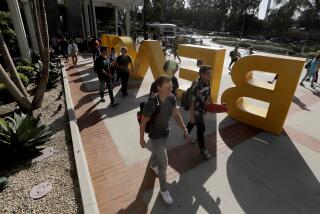Freeze the fees
- Share via
It’s budget time again for California’s public university systems. Every November, the California State University trustees and the University of California regents start planning for the next fiscal year. Everybody is predicting that the coming budget cycle is going to be particularly tough, with revenues flat and a deficit projected to be as high as $10 billion.
With a fiscal crunch looming, the Cal State Board of Trustees and the UC Board of Regents feel like they’re wearing bull’s-eyes. California’s great public universities are always tempting targets for budget cutters, in part because their boards have been too willing to increase student fees when threatened with lagging state support.
We’ve been creeping down that road toward privatization for years, slowly shifting the cost of running our public universities from the public at large to students and their families. Over the last 13 years, as the cost of living went up by 40% in California, total student fees for resident undergraduates at Cal State increased by 90%, and at UC by about 110%.
Enough is enough. Cal State and UC fees should be stabilized at current levels, in constant dollars. That means no future increases except to keep pace with inflation.
Putting money into higher education is one of the soundest infrastructure investments that California can make. California’s public universities pay for themselves: For every $1 spent, about $3 comes back to the state as a byproduct of a larger economy and higher incomes.
Of course, we must demand administrative efficiency and financial accountability. But we must also halt the trend toward privatization.
It is false to think that if Cal State and UC charge “market” tuition, all their operating expenses will be met, let alone the capital cost of new facilities. Great universities do not live by tuition alone. The top price of college tuition is largely set by Ivy League universities, and some others such as Duke and Stanford. With a few exceptions, these elite schools are not state supported. Instead, they rely on huge private endowments to subsidize tuition and fund scholarships for students who need financial assistance and who qualify for admission. Cal State and UC lack such substantial endowments. Even at full-bore Ivy-League tuition levels, forcing our state universities to rely solely on fees would lead to layoffs, enrollment restrictions and, ultimately, a serious diminution in academic quality.
Also, charging the same tuition as private universities would drastically curtail access to higher education for low-income Californians. Some state leaders have suggested that if we cut direct support to state universities, that money could generously be redirected by the governor and the Legislature to finance need-based scholarships. That is a fantasy on a good day and a dangerous delusion in times of fiscal crisis.
The best way to improve the lot of the less fortunate is to grow the entire economy, not to wrestle over who gets what slice of a static economic pie. And the surest way to retard the growth of California’s economy is to invest less in the structural foundation of California’s prosperity -- an educated, technologically sophisticated workforce.
There is a deeply flawed notion out there that the only people who benefit from universities are those who enroll, and that state support for higher education is just a subsidy for high-income families who send their kids to college. Getting an education is not the same as buying a car or hiring someone to paint your house. Education is a public good, like highways and waterways, like national parks and the armed services. Education benefits all and protects all.
California has become one of the world’s great centers of intellect, imagination and commerce because of our commitment to top-flight higher education. And this commitment has literally paid for itself, in the form of a highly educated workforce and research and scholarship that attract industry. The average income of workers with a college degree is 60% higher than that of workers with only a high school degree, and these college graduates pay 80% more in taxes than do high school graduates. Moreover, as many as two-thirds of all jobs created in California over the next decade are likely to require education beyond high school.
Public higher education is California’s golden goose. We should feed it, not starve it or sell it off.
More to Read
Sign up for Essential California
The most important California stories and recommendations in your inbox every morning.
You may occasionally receive promotional content from the Los Angeles Times.










